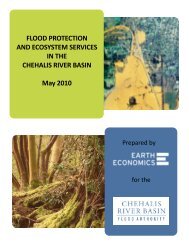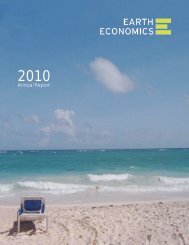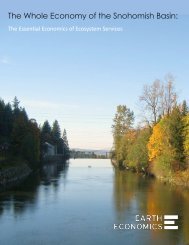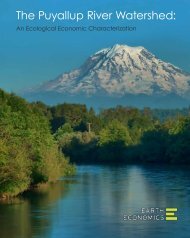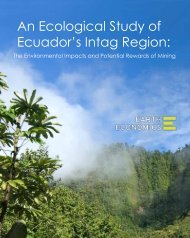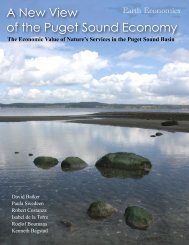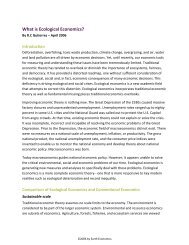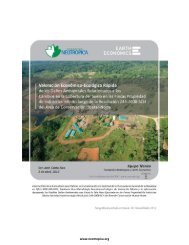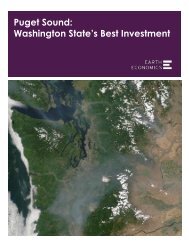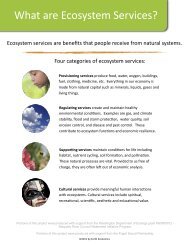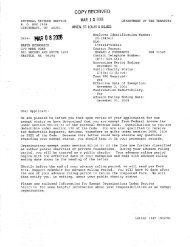The Spot Prawn Fishery: A Status Report - Earth Economics
The Spot Prawn Fishery: A Status Report - Earth Economics
The Spot Prawn Fishery: A Status Report - Earth Economics
Create successful ePaper yourself
Turn your PDF publications into a flip-book with our unique Google optimized e-Paper software.
<strong>The</strong> <strong>Spot</strong> <strong>Prawn</strong> <strong>Fishery</strong>: A <strong>Status</strong> <strong>Report</strong><br />
ment policy that states that only license fees for<br />
access should be regulated. Fees for additional<br />
management services will be provided voluntarily<br />
by fishers through Joint Project Agreements between<br />
representative industry associations and<br />
the Department (Boutillier, Fisheries and Ocean<br />
Canada. Pers. comm., June 2001).<br />
Commercial fishers will pay a C$320 (±US$225)<br />
license fee for the 2001 fishery. As a pre-condition<br />
of license, the fisher will be responsible for securing<br />
third-party services to provide trap tags, inseason<br />
hail services, on-board gear inspections,<br />
and biological sampling. <strong>The</strong> cost is estimated at<br />
C$1,700–2,000 (±US$1,200–1,400) per vessel,<br />
depending on whether the vessel is on a singleor<br />
double-license status. Only vessels active in the<br />
fishery must make arrangements for these services.<br />
Fisheries and Oceans will be seeking funding<br />
from the industry for stock assessment and additional<br />
management activities.<br />
Bootleggers, Poaching, and<br />
Illegal <strong>Prawn</strong> Sales<br />
<strong>The</strong> purchase of out-of season fresh prawns in<br />
bars and restaurants is well known. <strong>The</strong> illegal<br />
sale of prawns is a big concern in British Columbia,<br />
despite the fact that the value of spot prawns is<br />
higher in the export market than in the illegal<br />
market, and the fact that the majority (95%) of<br />
spot prawn product is legally caught and adequately<br />
reported. Poaching is a conservation concern,<br />
particularly where it is concentrated in areas<br />
that are closed for ecological or conservation reasons.<br />
Illegal activity of this nature is difficult to<br />
quantify, let alone investigate and prosecute. <strong>The</strong><br />
Department believes that bootleggers—individuals<br />
who catch prawns using a recreational license,<br />
then sell the catch privately—are largely those<br />
responsible for the illegal supply of spot prawns.<br />
WASHINGTON SPOT PRAWN FISHERY<br />
Biological <strong>Status</strong> of the <strong>Spot</strong> <strong>Prawn</strong><br />
<strong>The</strong>re has been virtually no ecological research<br />
on the spot prawn in Washington. Information<br />
regarding the biological status of spot prawns, and<br />
of Washington pandalid shrimp stocks in general,<br />
is limited (<strong>The</strong>rese Cain, WDFW. Pers. comm.,<br />
March 2001). <strong>Spot</strong> prawns are found in Washington’s<br />
offshore (coastal) and inshore (Puget Sound<br />
and Northern Straits of San Juan de Fuca) waters.<br />
Much of the portion of Puget Sound that is between<br />
40 and 50 fathoms (240–300 feet) deep is<br />
believed to support spot prawn populations (Mark<br />
O’Toole, WDFW. Pers. comm., June 2001). It is likely<br />
that spot prawn life-history characteristics vary<br />
depending on whether the population is in<br />
enclosed waters, such as Puget Sound, or open<br />
waters, such as the Washington coast. Both<br />
inshore and offshore distribution is believed to<br />
be patchy.<br />
Existing management systems are grounded in<br />
area-specific knowledge of historical harvests.<br />
<strong>The</strong> size, genetic structure, number and/or location<br />
of the different stocks, and the interactions<br />
between them are virtually unknown. Recruitment<br />
to the fishery is also an unknown; it is<br />
unclear whether larvae are transported from<br />
one area to another, or whether an area provides<br />
its own recruitment. It is speculated that, “given<br />
the complex current patterns and topography of<br />
the area . . . there are several genetically distinct<br />
sub-populations” (Lowry 2000).<br />
<strong>The</strong> offshore topography at spot prawn depth is<br />
complex, and the shelf break comprises several<br />
submarine canyons. <strong>The</strong>se canyons tend to contain<br />
counterclockwise eddies that may serve as<br />
larval retention devices. Canyons tend to be are<br />
as of greater upwelling, and as such could provide<br />
abundant food supplies and enhanced levels<br />
of productivity (Hickey 1995, 1997; Klinck 1996).<br />
Larval retention could lead to genetically distinct<br />
populations in each of the canyons. Even<br />
if this is not the case, it is believed that certain<br />
marine areas serve as larval sources, others as<br />
sinks (Lowry, University of Washington School<br />
of Fisheries. Pers. comm., May 2001).<br />
Complex geography and currents dominate the<br />
inshore Puget Sound region and could similarly<br />
limit larval transport and constrain gene flow.<br />
<strong>The</strong> Sound forms a part of a large fiord system<br />
made up of a number of distinguishable terrestrial<br />
and marine features that effectively divide it<br />
into distinct regions. Tides, wind, and terrestrial<br />
runoff govern water transport. Inshore areas like<br />
the Whidbey Basin or Hood Canal Basin exhibit<br />
slow turnover times (Ebbesmeyer, C.C. et al.<br />
1984). <strong>The</strong> combination of these factors may<br />
reduce passive larval transport and enhance the<br />
retention of larvae in the basins where they<br />
hatch. Gene flow between basins would be<br />
negligible under these conditions.<br />
Washington Sea Grant is currently funding a<br />
three-year program, <strong>Spot</strong> <strong>Prawn</strong> Stock Structure<br />
24



